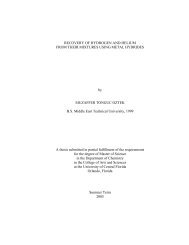You also want an ePaper? Increase the reach of your titles
YUMPU automatically turns print PDFs into web optimized ePapers that Google loves.
The thermogram associated with the subsequent dehydriding of the alloy<br />
exhibited an endothermic event, ascribed to the loss of hydrogen from the alloy, at an<br />
onset temperature of approximately 230 ºC. The amount of hydrogen released was<br />
limited to 0.15% at 250 ºC, which was not sufficiently hot for complete dehydriding. The<br />
sample was dehydrided again and 3% H was released at about 350 ºC. The thermogram<br />
and the percent hydrogen desorbed plots are given in Figures 11 and 12. In the<br />
thermogram, the endothermic peak is followed by two smaller exotherms. The exotherms<br />
are due to the re-absorption of the released hydrogen. This re-absorption occurs as the<br />
temperature decreases during the cooldown cycle.<br />
DSC 111<br />
Heat Flow/mW<br />
Exo<br />
100<br />
Figure: Experiment:Tonguc Mg2Ni 2nd dehydriding 20040520_3 Crucible:Steel<br />
Atmosphere:H2<br />
20/05/2004 Procedure: hydriding (Zone 1)<br />
Mass (mg): 109.5<br />
Sample temperature/°C<br />
350<br />
50<br />
300<br />
250<br />
0<br />
200<br />
-50<br />
150<br />
-100<br />
100<br />
-150<br />
50<br />
0 500 1000 1500 2000 2500 3000 3500 4000 4500 5000 5500<br />
Time/s<br />
Figure 11: Thermogram for dehydriding of Mg 2 Ni.<br />
39



